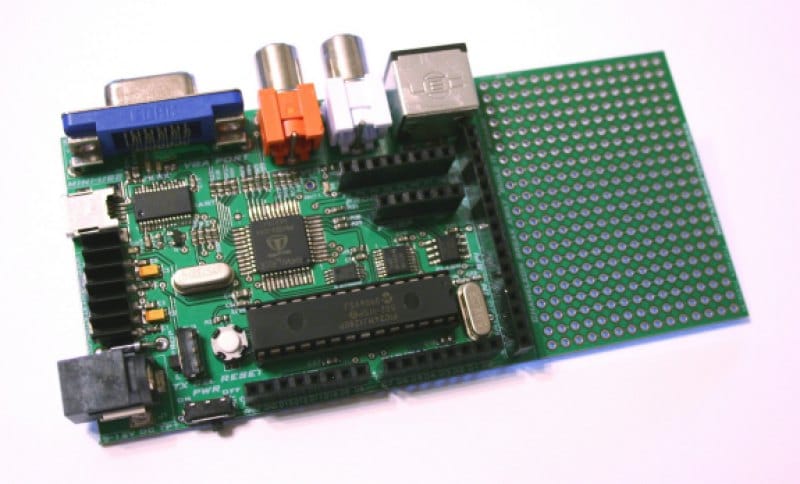

Part Number: TDKCHA001
CHAMELEON 16-BIT DEVELOPMENT KIT
Overview
This product is no longer available for sale.
The ChameleonTM 16-Bit Development Kit from Nurve Networks is the evolution of the high performance, small footprint, application development board. This credit card sized computer includes (2) processors, (9) processing cores, 1 MByte of on board FLASH, 64K of EEPROM, and over 200 MIPS of processing power! The numerous I/O interfaces include composite video for NTSC/PAL generation, VGA, audio out, PS/2 for keyboards and mice. Additionally, the Chameleon has a number of general purpose digital I/O lines and analog inputs making the Chameleon perfect for industrial controllers, experimentation, education, wearable computing, or hobbyist use.
The real power of the Chameleon is based on its dual processor design. The Chameleon uses a PIC24 MCU running at 40MHz as the master processor, and a multi-core Propeller chip as the media slave processor. Thus, instead of taxing a single processor system to do everything, the Chameleon offloads all media processing to the Propeller chip, which has 8 processing cores to perform tasks such as generate video, audio, read keyboards and mice, etc. Complex and rich media applications can be developed easily by leveraging the Propeller chip's media rendering abilities and huge software library. For example, applications can generate TV signals, VGA output, read keyboards and mice, with only a few lines of code.
Documentation
|
Title
|
|||
|---|---|---|---|
| Chameleon 16-Bit User Guide | Download |
Additional Resources
Specifications
Technical Specifications
The Chameleon design uses a PIC24 MCU as the MASTER (client) and the Propeller multi-core processor as the media SLAVE (server). Commands are sent to the Propeller chip via the SPI interface and a set of drivers on the Propeller parse, execute, and dispatch the messages to the various media objects running on multiple cores. Thus, printing characters on a NTSC or VGA display is as simple as sending a few bytes through the hardware SPI interface. The Propeller slave processor does all the rest with the supplied drivers.
Included with the package is a 150+ page electronic manual that describes how the Chameleon works with examples of using the media processing capabilities. Also, the manual illustrates the hardware design, how to use MPLAB IDE, a custom text editor based IDE, Propeller IDE, software installation, the media API, and how to write custom drivers if you wish.
The Chameleon comes pre-loaded with a Microchip bootloader, so that protocol compatible tools can be used to program the Chameleon over the USB port. However, it is recommend that you purchase a PICkit in-circuit programmer/debugger (or similar), so that MPLAB IDE can be used to debug applications, as well as re-load the FLASH bootloader in case it becomes damaged. The Propeller media processor can be programmed with a simple serial protocol right over the USB serial port, so no additional hardware is required.
The Chameleon has a full arsenal of I/O devices and features including:
- Runs Microchip PIC24 16-bit applications, as well as Propeller Chip applications
- Microchip PIC24HJ128GP502 16-bit processor with 128K FLASH / 8K SRAM running at 40 MIPS (pre-loaded with Microchip bootloader)
- Parallax Propeller multi-core processor with 8 cores running at 20 MIPS for 160 MIPS of processing power
- 1 MByte SPI FLASH memory
- 64 Kbyte EEPROM (for Propeller processor boot program storage)
- 500mA max power 3.3/5V dual supplies (power by USB or external 9V DC supply with hot swapping)
- Mini USB port with USB to serial UART (FTDI chip), used for programming the Propeller and PIC24 in bootloader mode, as well as for serial communications
- VGA output with 2x2x2 RGB
- Composite video output for NTSC/PAL video
- Microchip 6-pin ISP programming port (programmer not included)
- PS/2 keyboard/mouse port
- I/O headers exporting digital, analog input inputs and power (95% compatibility with Arduino I/O headers)
- Exported SPI, Serial and I2C buses
- Removable XTALs for over clocking